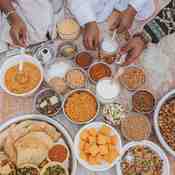
The patterns of nutritional consumption in India have been clarified by the Household Consumption Expenditure Surveys (HCES), which were carried out between August 2022 and July 2024. These surveys provide vital information on food consumption and the population's subsequent nutritional intake. The publication, "Nutritional Intake in India," compiles the data and is a useful tool for academics and policymakers.
Overview of the Survey
The purpose of the HCES was to evaluate household food consumption trends. It concentrated on consumption of calories, protein, and fat. The surveys, which included both rural and urban portions, were carried out in two stages. The information gathered provides information on the nutritional condition of various demographic groups.
Analysis of Caloric Intake
The average per capita calorie consumption in India increased little from 2022–2023 to 2023–2024 in both rural and urban areas. In 2022–2023 and 2023–2024, rural regions registered 2233 Kcal and 2212 Kcal, respectively. For the same times, urban regions recorded 2250 and 2240 Kcal. In all sectors, the calorie consumption of the lowest fractile groups increased, suggesting better access to food.
Breakdown of Nutrients
Favorable decreases were recorded in daily average intake of fat and protein as well. In 2022 2023 and 2023 2024, the rural India consumption of protein was 61.9 and 63.2 grams respectively. The same growths were observed in urban areas. The consumption of fat has risen to 69.8 grams and 70.5 grams in urban and rural areas respectively as compared to 60.4 grams previously.
Regional Differences
There were notable differences in calorie consumption across states. Higher calorie consumption was associated with higher Monthly Per Capita Consumption Expenditure (MPCE). A more fair allocation of food resources was reflected in the closing gap between the top and lowest fractile groups.
Trends Over Time
Prior surveys' data show a steady rise in protein and calorie consumption between 2009–10 and 2023–24. This pattern indicates continuous advancements in India's nutritional standards and food security.
Sources of Protein
Cereals continue to be the predominant protein source, accounting for 46-47% in rural regions and around 39% in urban areas. Nonetheless, the proportion of grains has significantly decreased over time, which has been counterbalanced by increases in protein from meat, fish, eggs, and dairy products.
Modified Consumption of Nutrients
Compared to unadjusted values, corrected nutrient consumption estimates were somewhat lower. Meals bought at the market and meals cooked for non-household members are included in this adjustment. The paper highlights how crucial it is to accurately estimate nutrient consumption in order to comprehend actual dietary patterns.
Month: Current Affairs - July 06, 2025
Category: indian